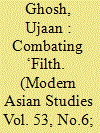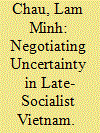|
|
|
Sort Order |
|
|
|
Items / Page
|
|
|
|
|
|
|
| Srl | Item |
| 1 |
ID:
168784


|
|
|
|
|
| Summary/Abstract |
This article provides qualitative case studies and applies citizenship theory to reveal the way in which being in receipt of a cash transfer can help local poor and excluded Dalits to understand what it means to be a citizen of Nepal's state. Cash transfers can contribute to an individual's subjective sense of inclusion and citizenship. Although Dalits encounter disparities and rights abuses when dealing with local government over their cash transfer entitlements, their responses reveal a sense of agency in the positive way in which they interpret their entitlements. Although they may be mistreated at the local level, they feel valued because the central ‘state’ recognizes their plight and identity. Cash transfers are understood by Dalits through the lens of social exclusion, patronage, and the hierarchical society in which they live. They are an effective way of reaching large numbers of formerly excluded citizens and indicate that the state now includes them. As such, they can contribute towards building an inclusive state.
|
|
|
|
|
|
|
|
|
|
|
|
|
|
|
|
| 2 |
ID:
168779


|
|
|
|
|
| Summary/Abstract |
This article interrogates the urbanization of Puri at the time of the cholera epidemic in the latter half of the nineteenth century. In the wake of the epidemic the colonial state took serious steps to reorder the urban landscape of the pilgrim town in general and Puri in particular. However, in Puri the narrative of infrastructural development is slightly complicated by the presence of the temple of Jagannath which acted as an alternative public body. Thus, on every occasion the colonial state had to negotiate with the temple in order to facilitate urban governance in Puri. As a result, I argue, Puri's urban landscape could only develop through interaction and negotiation between the temple and the state.
|
|
|
|
|
|
|
|
|
|
|
|
|
|
|
|
| 3 |
ID:
168783


|
|
|
|
|
| Summary/Abstract |
This article uses the case of the London Missionary Society (LMS) in China to argue that disruptive cultural technologies—namely organizational forms and tools—were just as significant within Christian mission encounters as religious doctrines or material technologies. LMS missionaries did not convert as many Chinese to Christianity as they hoped, but their auxiliary efforts were more successful. The LMS mission project facilitated the transfer of certain cultural technologies such as church councils to administer local congregations or phonetic scripts to facilitate literacy. Once in the hands of native Christians and non-Christians alike, these cultural technologies could be freely adapted for a variety of purposes and ends that often diverged from the missionaries’ original intent and expectation. This article draws on the letters and reports of missionaries of the London Missionary Society in North China from roughly 1900 to 1930—the period during which self-governing Protestant congregations took root in China and many places around the world. The spread of church government structures and a culture of Bible-reading enabled Chinese within the mission sphere to create new forms of collective life. These new forms of community not only tied into local networks, but also connected to transnational flows of information, finances, and personnel. Native Christian communities embraced new, alternative sources of community authority—the power of God working through a group of ordinary people or through the biblical text—that proved both attractive and disruptive.
|
|
|
|
|
|
|
|
|
|
|
|
|
|
|
|
| 4 |
ID:
168782


|
|
|
|
|
| Summary/Abstract |
‘Toleration’ is a notoriously slippery concept, and yet, as recent scholarship on the historical roots of Indian secularism has implied, it was a guiderail for East India Company decision-making in Bengal in the late eighteenth century. What, then, was the outcome when Europeans encountered what they were quick to regard as South Asian patterns of ‘toleration’? This article argues, first, that a medley of competing policy visions emerged from this interaction and, second, that where these visions overlapped was in perceiving political gain to ensue from facilitating existing South Asian devotional practices. A corollary consequence of this still-emergent policy framework was that most East India Company personnel were loath to intervene in any way but a reactive one when conflicts between devotees of Durga on parade and observers of the Shia Muslim holy day ashura escalated into reprisals and street violence in Calcutta in September 1789.
|
|
|
|
|
|
|
|
|
|
|
|
|
|
|
|
| 5 |
ID:
168775


|
|
|
|
|
| Summary/Abstract |
Islamic socialism was a major intellectual and political movement in Indonesia in the twentieth century, with ongoing influences until today. However, this movement did not follow the most common narratives of Indonesian intellectual history, which trace religious influences to the Middle East and political movements to anti-colonial reaction in terms framed by the Dutch. Rather, the first major Indonesian proponent of Islamic socialism, H. O. S. Tjokroaminoto, took his thinking on Islamic socialism directly from the English-language work of a South Asian itinerant scholar, Mushir Hosein Kidwai, in a process that most likely had the minority Ahmadiyyah community as intermediaries. Future Islamic socialist thought, much of it influenced by Tjokroaminoto, continued to echo through Indonesian secular nationalism, political Islam, and even Islamism. Studying the intellectual origins of Islamic socialism in Indonesia, then, shows not only the roots of an important strand of Southeast Asian politics in the last century, but also the importance of alternative currents of thought (South Asian, outside the mainstream, Anglophone) in Southeast Asian Islam.
|
|
|
|
|
|
|
|
|
|
|
|
|
|
|
|
| 6 |
ID:
168780


|
|
|
|
|
| Summary/Abstract |
In April 2014, the Cellular Jail, Andaman Islands, was submitted to the UNESCO World Heritage Site Tentative List for India. The image of the colonial jail, depicted on coins, stamps, and first day covers, symbolizes both the suffering and heroic struggle of India's freedom fighters. Considering how international, national, and local state forces have attempted to ‘freeze’ the meaning of the Cellular Jail, this article questions what has been excluded or obscured from collective memory. Furthermore, it explores the relationship between contending political wills and the symbol of the Cellular Jail through a particular focus on recent struggles between Hindu and secular nationalists over its appropriation. By considering the production of the symbol of the Cellular Jail, this article challenges the narratives at the heart of modern nation-building and demonstrates their intrinsic instability.
|
|
|
|
|
|
|
|
|
|
|
|
|
|
|
|
| 7 |
ID:
168776


|
|
|
|
|
| Summary/Abstract |
This article examines the Indian poet-philosopher Muhammad Iqbal's appropriation by three Nadwat al-‘Ulama scholars: Sayyid Sulayman Nadwi (d. 1953), Abu'l-Hasan ‘Ali Nadwi (d. 1999), and ‘Abd al-Salam Nadwi (d. 1956). It argues that the particular depictions of Iqbal by the Nadwa ‘ulama can be mapped onto larger evolutions within the institute. The early Nadwa ‘alim Sulayman Nadwi imagines Iqbal as a Muslim leader par excellence. A more conservative understanding of Islam emerged with the later Nadwa ‘ulama. They emphasize traditional theological ideas, particular modes of piety, and ritualistic actions. The article suggests that the later Nadwa ‘ulama’s writings on Iqbal are reflective of this particular understanding of Islam and morality, although there are two distinct responses to the poet. The above examination of the Nadwa is placed within its broader historical context. In so doing, the article contends that the impact of the political milieu in India must be taken into account to understand shifts in the Nadwa and South Asian Islam more broadly. It also asserts that the political environment in South Asia influenced Iqbal's reception by the Nadwa ‘ulama as well as by Muslims in South Asia and beyond. Additionally, this article argues that all three works by the Nadwa ‘ulama are subjective portrayals informed by the social imaginaries of their authors. In fact, in a broader sense, all works of narrative historiography are subjective accounts. This realization problematizes the boundaries between the categories of historiography and hagiography, and this research calls for a rethinking of these tensions.
|
|
|
|
|
|
|
|
|
|
|
|
|
|
|
|
| 8 |
ID:
168774


|
|
|
|
|
| Summary/Abstract |
This article makes a case for Vietnam as a distinctive example of late- and post-socialist marketization, a painful experience that has brought widespread immiseration to rural societies within and beyond Asia. Building on extensive ethnographic fieldwork in a northern Vietnamese village, I explore a hitherto under-researched aspect of Vietnam's massive social and economic transformation in the 30 years since the onset of market transition or Renovation (Đổi mới): the surprising ways in which rural households have negotiated both the risks and opportunities of the state's push to de-cooperativize and marketize village livelihoods. The state expects that a minority of rich farmers will rapidly move into large-scale, mechanized farming, while the majority will abandon small-scale subsistence farming to specialize in trade or participate in industrial waged employment. Surprisingly, all village households insist on being đa gi năng, that is, on retaining multiple livelihood options instead of following the official modernization scripts. Their refusal to follow state plans is not market-averse ‘resistance’, but something rarely documented in the literature on peasant life in marketizing contexts: a local sense of agency and taking personal responsibility for the security and long-term welfare of their families, in the face of highly unpredictable state policies.
|
|
|
|
|
|
|
|
|
|
|
|
|
|
|
|
| 9 |
ID:
168777


|
|
|
|
|
| Summary/Abstract |
The article discusses Saritā, one of the best-selling Hindi magazines of the 1950s, and the part it played in the establishment of the Hindi ‘middlebrow’ reader. While a rich and vibrant journal culture in Hindi had existed since the nineteenth century, what distinguishes the post-1947 Hindi popular magazine is the emergence of the middle class as a burgeoning consumer. Saritā defied prescriptions of Nehruvian state building, as well as the right-wing discourses of nationalism and national language prevalent in the post-Independence space. In addition, it reconfigured biases towards gendered reading and consumption processes, as well as encouraging increased reader participation. This article argues for Saritā’s role in the creation of a middlebrow reading space in the period immediately following Independence, since it not only packaged what was deemed wholesome and educational for the family as a unit, but also, most significantly, promoted readership in segments, with a focus on each individual's reading desires.
|
|
|
|
|
|
|
|
|
|
|
|
|
|
|
|
| 10 |
ID:
168778


|
|
|
|
|
| Summary/Abstract |
This article presents methodologies towards a multilingual literary history of Sri Lanka in the twentieth century by examining multilingual encounters or cultures through places, people, and institutions. Massey's concept of plural space underpins the study and gives rise to various strategies to build a multilingual literary history. The guiding research questions are: How do we construct multilingual literary histories in the context of language-based conflict? What can conflict environments teach us about approaches to multilingual literary histories and spheres? In addition to discovering future directions for intra-national comparative literary studies and documenting multilingual cultures and sites, I also focus on the changing geography of multilingualism in the twentieth century. As ideological separation of language spheres turned to real-world segregation through a series of policy shifts and institutional changes, we see that the pursuit of multilingual research takes us from organic, or naturally occurring, sites of multilingualism to orchestrated, or purposefully created, sites. Orchestrated sites work to counterbalance the decreasing opportunity for organic multilingual encounters in the context of ethnolinguistic conflict.
|
|
|
|
|
|
|
|
|
|
|
|
|
|
|
|
| 11 |
ID:
168781


|
|
|
|
|
| Summary/Abstract |
The Indian state treated the partition of Punjab as a ‘national disaster’ and training for refugee women was deemed essential to restore the social landscape; yet the kind of help it offered to refugee women rested on its clear assumptions and biases about the kind of work that was appropriate for them: women were offered training in embroidery, stitching, tailoring, and weaving, as these are associated with feminine and household-based skills. This article will reveal that the state rehabilitation enterprise was primarily masculine in focus. The state treated women refugees as secondary earners and as guardians of hearth, kith, and kin; it did not see them playing a definitive role in nation-building in post-colonial India. In the absence of state supportive policies, refugee women were compelled to take up informal jobs like petty trading, domestic service, and labouring work. This article suggests that refugee women were handicapped in the labour market at their very point of entry. It traces the history of women's informalities in Delhi. In doing so, it investigates the feminization and commercialization of urban space in twentieth-century Delhi. It urges that women made space in more than one way: identifying fragmentary livelihoods, producing small-scale capitalism, and creating informal markets.
|
|
|
|
|
|
|
|
|
|
|
|
|
|
|
|
|
|
|
|
|